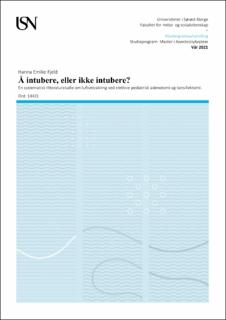| dc.contributor.advisor | Flynn, Fiona M | |
| dc.contributor.author | Fjeld, Hanna Emilie | |
| dc.date.accessioned | 2023-12-07T17:41:34Z | |
| dc.date.available | 2023-12-07T17:41:34Z | |
| dc.date.issued | 2022 | |
| dc.identifier | no.usn:wiseflow:6701905:52775426 | |
| dc.identifier.uri | https://hdl.handle.net/11250/3106499 | |
| dc.description.abstract | Innledning: Adenotomi og tonsillektomi er to av de vanligste inngrepene utført på barn. Barn som møter for disse inngrepene kan potensielt ha luftveisutfordringer grunnet hypertrofi og aktive eller nyliggjennomgåtte luftveisinfeksjoner. Selv om endotrachealtuber er mest brukt for luftveissikring under disse inngrepene for den pediatriske populasjon, bruker enkelte anestesipersonell larynksmasker.
Metode: I dette studiet er det gjennomført et systematisk litteraturstudie for å undersøke hvilken metode for luftveissikring som er mest egnet ved pediatriske adenotomi og tonsillektomi. 10 studier ble indentifisert og inkludert, og innholdet analysert via tematisk analyse.
Resultat: De fleste studiene finner få forskjeller mellom bruk av larynksmasker og endotrachealtuber som luftveissikring ved adenotomi og tonsillektomi hos barn. Endotrakealtuber ser ut til å kunne gi mer hoste, gaging og «noisy breathing» postoperativt enn larynksmasker. Utfordringer med bruk av larynksmasker ser ut til å være at det er mer utfordrende å plassere gagen for å fasillitere det kirurgiske feltet, og at det i noen tilfeller kan redusere kirurgens tilgang til feltet. Det ble ikke avdekket noen forskjeller i luftveisverktøy på forekomst av larynksspasme eller andre alvorlige komplikasjoner.
Konklusjon: Det ser ut som om både endotrachealtuber og larynksmasker er gode alternativer for luftveissikring ved adenotomi og tonsillektomi hos barn | |
| dc.description.abstract | Introduction: Adenoidectomy and tonsillectomy are two of the most common surgical operations performed on children. Airway management may be challenging for children undergoing these operations due to hypertrophy and active or recent respiratory infections. Endotracheal tubes are most commonly used to secure the pediatric airway during these procedure, though some anesthesia providers preferer to use laryngeal mask airways.
Methods: In this study a systematic literature review was conducted to investigate which method of securing the airway is most appropriate for pediatric adenoidectomies and tonsillectomies. 10 studies were included. The content was analyzed using thematic analysis.
Results: The analysis revealed few differences between laryngeal mask airways and endotracheal tubes in the airway management of children undergoing an adenoidectomy or tonsillectomy. Endotracheal tubes were found more likely to cause coughing, gaging and post-operative noisy breathing than the laryngeal mask airway. The laryngeal mask airway was found to be more challenging when positioning the mouth gag, and could in some cases restrict the surgeon´s access to the surgical site. There was no difference between the two airway devices with regards to the occurrence of laryngospasms and other serious complications.
Conclusion: Thus it appears that both the endotracheal tubes and laryngeal mask airway are reasonable alternatives for securing the pediatric airway during adenoidectomies or tonsillectomies. | |
| dc.language | nob | |
| dc.publisher | University of South-Eastern Norway | |
| dc.title | Å intubere, eller ikke intubere? En systematisk litteraturstudie om luftveissikring ved elektive pediatrisk adenotomi og tonsillektomi | |
| dc.type | Master thesis | |
